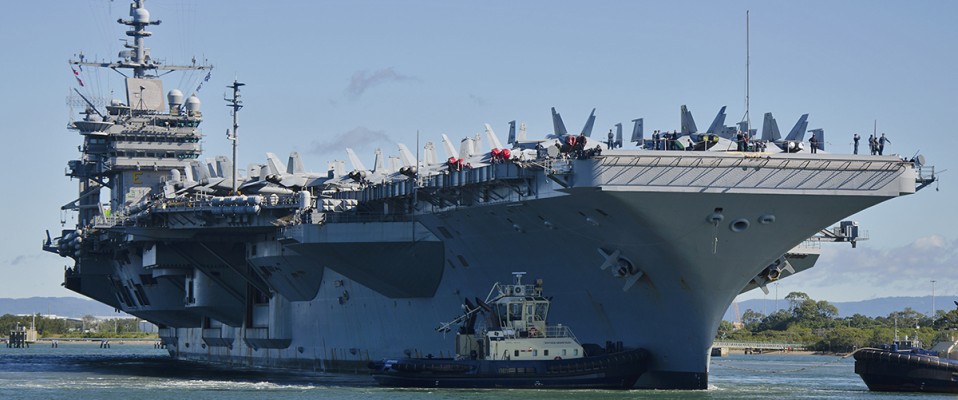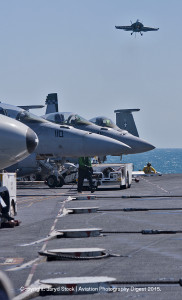The Last WESTPAC Cruise for the ‘Spirit of Freedom’
Article and Photos by Jaryd Stock
A
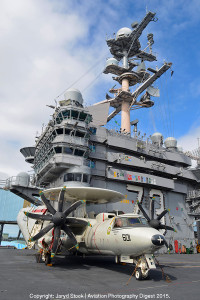
A Northrop Grumman E-2C-2000 Hawkeye from Carrier Airborne Early Warning Squadron 115 (VAW-115) “Liberty Bells” rests on the USS George Washington
Leading up to the this historic CVN changeover, the “Spirit of Freedom” was busy being put through her paces by her ever wonderful Captain and crew, with Carrier Air Wing 5 (CVW-5) from Naval Air Facility Atsugi, Japan embarked onboard. The GW was off on her final WESTPAC cruise as a part of Carrier Task Force 70 and the 7th fleet in the 7th fleet’s Area of Responsibility (AoR). The Supercarrier and her crew said “sayonara” to her home port of Yokosuka on May 18, 2015, leaving behind a connection that was developed with the locals in the Kanagawa prefecture for over seven years. The carrier was the first nuclear-powered carrier to be deployed outside of the continental U.S.. It was a touching moment where a few tears were shed by those who would carry on with the GW, as she would swap hulls with the RR later in the year and then head to Virginia.
With the carrier finally setting sail over the next couple of days, CVW-5 would depart Atsugi to deploy on their beloved carrier once more for the final time. The GW would head South, partaking in exercises and war games that would eventually lead up to the biggest exercise held in the Southern Hemisphere, Exercise Talisman Sabre 2015. Talisman Sabre 2015 would be held in the northern part of Australia. With the nearest capital city being Darwin, a lot of U.S. and Australian units would use the Royal Australian Air Force Base for deployment when partaking in different scenarios during the exercise.
For the George Washington crew, and those apart of CVW-5 leading up to the Talisman Sabre, it was about maintaining that same level of professionalism they were all accustomed to. This was no “good luck, farewell” cruise. For the members of the GW or the CVW onboard, it was about making sure that they were keeping the edge and intensity that ensures the crew maintains a high level of preparedness. For seven years, the USS George Washington was the jewel in the crown of the U.S. Navy’s 7th fleet, and as some would say, 90,000 tons of diplomacy, a symbol of the American presence in the Pacific. At the final dock-side news conference before the GW left, when asked if these carriers were now part of an obsolete program, Rear Admiral John Alexander stated, “I would say that when other countries are building aircraft carriers, they’re doing it for a reason and really you can have a bigger influence in the region.”
The Final WESTPAC Cruise, A Captain’s Perspective…
After reaching the port of Brisbane in Australia on June 19, 2015 for a five day liberty call, Aviation Photography Digest had a chance to sit down with Captain Timothy Kuehhas, the commanding officer of the USS George Washington. Capt. Kuehhas, a native of Sayville, New York, was asked what it was like to command such an iconic vessel in the 7th fleet and also, what it is like on his final WESTPAC cruise with the George Washington. “It’s a bittersweet moment for myself and the rest of the crew, now that we find that we are in Australia because we know we have various tasks ahead and we love coming to Australia, but we also know that we are getting closer to that point when we do transfer with Reagan and for a lot of the crew around 2,500 of them they’ll be swapping over to the Reagan but I’ll be continuing on as CO of the ship until we finally reach Norfolk for its RCOH.”
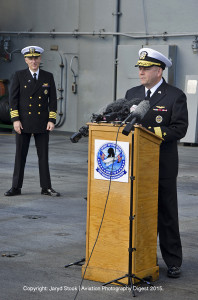
Rear Admiral John Alexander and Captain Timothy Kuehhas speak to a crowd aboard the USS George Washington
Asked what he will take away from being in command onboard the GW, Kuehhas stated: “I’ve been in command of the George Washington for 5 months now and every day is a learning experience on-board, and really, it’s been like that during my career. It’s such a unique and dynamic working environment that no two days are the same. There is always something that I have found that I will always learn from, and there is always a new challenge which is fun. In turn, now I have found that the crew learns from those challenges as well and those learning curves you get are valuable to growing in how to do things better and more proficient for yourself, but also for the team you work with as well. Hence, that is why we partake in these exercises such as Talisman Sabre…for us to learn and give the team onboard a chance to grow. And to be honest, I have had an absolute ball in working with the crew that I have. I look over my career and for 27 years it has been the same, and I can certainly say it’s true and certainly the case for this crew onboard, is that all of them are hard workers. All the sailors are hard workers and they do that with a big smile on their face too, they are pulling 12 to18 hours shifts on this carrier, and yet they are doing it with no complaints. Because they love their job, they love their country and want to pull together to ensure everything is done right.”
CO Kuehhas continues, “And for me, that’s inspiring to see the team I lead take that attitude when it comes to their work. You can see they love what they are doing, and you know every chance that my wife and I sit down and think about moving into the civilian world, we always say to each other we are never going to find this selfless dedication by anyone anywhere else in the world. When I was younger, coming through the ranks there were always officers older and higher than me that would really take time to help guide me in what I was doing and what I wanted to achieve, and that is something that I try really hard to instill with ones under my command now, try and impart that helping hand and confidence to them. And really, it’s something that I always say there is not enough time for and just wished I could do it some more. And, because everyone here are such great people, I just wished I had the time to spend that time with them. And, when you get to my age now, and have had the opportunity to lead, the men and women, now I kind of view them as my children in many respects. My wife and I have 4 children and 2 of them are in college, so a lot of the sailors onboard the ship are around 19-20 years of age around the same age as my oldest children. You gain a different perspective on things and do start to view each one as a child.”
Captain Kuehhas is a former Electronic Countermeasures Officer that flew in EA-6B Prowlers, and was once the commanding officer of Electronic Attack Squadron (VAQ) 132 ‘Scorpions’. Reflecting on the retirement of the Prowler, Kuehhas lamented that, “that is going to be a bittersweet time too, for not only myself, but the Navy as well. The Prowler was such a great aircraft to operate with and was really a Cadillac of the skies, was loud was a great EW platform. But as time goes by, better platforms come along and right now that is fulfilled by the Growler, such as VAQ-141 (‘Shadowhawks’ apart of CVW-5) which operates onboard the GW now. The Growler just has so much more capability now, and the Prowler has given its nation a full and rewarding service, but it’s time for it to be replaced. But, it’s all a bittersweet moment looking at those times in history, such as the Prowler, and also this ship that will end its seven year association being forward deployed in Japan but it’s exciting to be a part of.”
With 5 days for the crew to enjoy liberty before the final exercise, the GW and her captain and crew got to relax and have a bit of a breather before the biggest exercise in Australian waters got underway. Where the ship would form the HQ for Carrier Task Force 70, under the command of Rear Admiral John Alexander, and act as the central command for U.S. Navy ships and units partaking in the exercise for a three week period during June.
Exercise TALISMAN SABRE 2015
As mentioned earlier, the final part to the George Washington’s final WESTPAC cruise was being deployed to the top end of Australia to participate in Exercise Talisman Sabre. With over 30,000 personnel, 24 ships, led by the USS George Washington (CVN-73) and with over 200 aircraft participating, it was the Australian Defence Force’s largest exercise ever undertaken in this region. Most of the exercise this year took place around the training areas in the Northern Territory. This was different to previous years, as the exercise was usually held in the state of Queensland at the Shaolwater Bay training area near the City of Rockhampton. A decision was made to move the exercise to the Northern Training Area Complex as it offers greater room, especially for the amphibious operations such as those conducted by the 31st Marine Expeditionary Unit on Board the USS Bonhomme Richard/ USS Green Bay/ Ashland, allowing air operations utilising and moving large scale forces to be carried out with ease. In an example, the land-based training area located in the ‘Top End’ of Australia is the equivalent in size to the state of Connecticut in the United States.
The primary aim of the exercise remains improving Australia-U.S. readiness and the way we operate together through combined training, and providing great interoperability between the two nations.”
- Vice Admiral David Johnston
Australia’s Chief of Joint Operations, Vice Admiral David Johnston, said the inclusion of the New Zealand and Japanese forces for the first time would enable the ADF to deepen its engagement with close defence partners in the region, but did not change the bilateral nature of the exercise between Australia and the United States. “The primary aim of the exercise remains improving Australia-U.S. readiness and the way we operate together through combined training, and providing great interoperability between the two nations,” VADM Johnston went on to say “that while Exercise TALISMAN SABRE remains Australia’s premier bilateral exercise with the United States, it provides an excellent opportunity for the ADF to practice operating with the New Zealand Defence Force and JSDF in a realistic training environment.”
The George Washington had a vital element embarked CVW-5, they were tip of the spear for Carrier Task force 70 (CTF-70), the task force of ships under the command Rear Admiral John Alexander, commander of the George Washington strike group. Apart from the 5 ships deployed with the carrier, the task force also encompasses the eight Squadrons from the Air Wing onboard. The Air Wing participated in their last exercise whilst deployed onboard the GW. RADM Alexander stated that “A typical mission was for the Air-Wing to support forces on the ground and work with our counterparts from Australia such as the Australian Army 2RAR and Ground Combat Element for the Marines and do some simulated drops and also small diameter live ordnance drops as well.” He went on to say… “We will situate the carrier about 200 miles out from the shore line, as we really don’t like to get up in the face, so to speak, of those we are battling against, we will sit the carrier around about that distance out. We can get closer or stay further back if we want to, but we are really designed to stay a fair way out from the action. And from here, we will launch our attack forces, our aircraft, to conduct a variety of missions that have been tasked to the various Squadrons. The Royal Australian Air Force, especially Number 3 Squadron that are basing out of RAAF Base Tindal with their F/A-18A’s, have been our red force where they have been employed to use a variety of simulated tactics to stop the advancement of blue force elements on the ground and the support we are giving to those elements from the Air.”
Asked about the success of these exercises in working with major partners in the region RADM Alexander stated: “This exercise is a great, valuable experience for us to work intricate maneuvers with our Australian counterparts and gives us that valuable interoperability where we can work together and grow in confidence with each other. A prime example is CVW-5 and 3 SQN from the Royal Australian Air Force working closely together. Mostly the different Squadrons from the Air Wing will mix in closely with the RAAF so they (RAAF) will be that force conducting those adversary tactics like a red force and we will come up against that, but with that we have an F-18 of some sort conduct a mission against an opposing F-18 of some sort from the RAAF. So even getting to that level does wonders for the closeness in working together and that helps a whole lot in the long run, which makes my life easier and is great for both nations.”
During each day, the various units within the Air Wing will conduct around two individual training missions a day, sometimes three a day, meaning they will go out in the morning, come back and then head out again in the afternoon. RADM Alexander went on say, “this also gives more time to work with our high end partners such as the Australians. People don’t realise that Australia and the U.S. have participated and fought side-by-side in every major conflict in the last century. So, it’s very important and it’s key to everything that we do, and are especially doing, during this exercise. It’s a chance to make sure that we are in-tuned with each other making sure our tactics are inline making sure we can plug and play together in high-end spectrum of operations that is really important, and is the reason why we are here and making sure we get that interoperability working together.”
Lt. David Robinson, strike operations officer for CVW-5, gave a little more insight on the Air Wings involvement. “The ultimate goal of conducting these exercises is to achieve and maintain interoperability between the U.S. and Royal Australian Air Force, as well as our other maritime components. The advanced level of training received through these exercises is the most rewarding part about conducting them. This training would not be able to be simulated in any other area of responsibility (AoR), and the land strike training we are doing are 1 of 10 large force strikes we are against simulated land adversaries in the various large training areas.”
During this time, another avenue of interoperability between the U.S. Navy and the Royal Australian Air Force was being achieved. CVW-5’s F/A-18E/F Super Hornet’s and EA-18G Growler’s were being supported in the air with refueling aircraft from RAAF’s 33 Squadron utilizing Airbus KC-30A aircraft. Based out of RAAF Base Darwin, 33 Squadron used the call sign: “CALTEX” during the exercise. Detachment Commander of the exercise for 33SQN, Squadron Leader Stephen Moneypenny said, “It marked a busy mission for the crew of four on the KC-30’s we usually refuel about half the number we have been doing on each refueling mission we undertake. Our primary receiver have been Carrier Air Wing 5 aircraft, and it has been great for us because we’ve only been working with them the last year or so, so we’re still learning their (U.S. Navy) refueling processes. SQNLDR Moneypenny went on to say, “this is great training for us. We’re getting familiarised with each other’s procedures, call signs, habits and nuances that make it a lot easier for all of us when we work together in the future which we can’t wait to do again.”
Take the Long Way Home
With Talisman Sabre completed and the key objectives obtained, analysed and lessons-learned reviewed, the crew of the USS George Washington, with CVW-5 onboard, started on their final voyage deployed in the 7th fleet’s AoR as a forward deployed carrier. It was what a lot of crew members had been looking forward to…the homeward bound journey back to San Diego. When the ship was closer to its destination, Carrier Air Wing 5 completed its mid-patrol fly-off on August 8, 2015. CVW-5’s more than 60 aircraft, from the 8 squadrons embarked upon the GW, have temporarily moved to Naval Air Station Fallon, in Nevada, in preparation to embark aboard the USS Ronald Reagan (CVN 76).
“There are always challenges when you have to move an entire air wing somewhere, but when you are forward-deployed naval forces this becomes second nature since we do it so often,” said CVW-5’s Command Master Chief Todd Wende. “Seventy percent of the air wing is going to Fallon for training while the other 30 percent is charged with ensuring spaces, berthing and shops are setup prior to our transit back.”
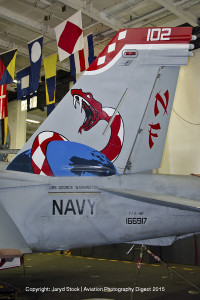
The tail art of a U.S. Navy Boeing F/A-18F Super Hornet from Strike Fighter Squadron 102 (VFA-102) “Diamondbacks”
CVW-5 participated in a variety of operations and received several coveted awards prior to the hull swap with Ronald Reagan during the 2015 patrol.
“Apart from participating in Exercise Talisman Sabre 2015 with our Australian counterparts, and performing large force interdiction strikes, maritime strike and multi-air-defence exercises, which is critical to the allied defence in the Asia-Pacific region,” said Wende. “We also, had the pleasure of having Vice Admiral Shoemaker on board to present four Battle ‘E’s and a Safety ‘S’ to five different squadrons.”
Despite moving to a new platform, Wende stated that CVW-5’s overall mission will stay consistent. “Our operations will remain the same, but with a new ship comes new spaces and new nuances that we will all have to learn to work through for the air wing,” said Wende. “It’s business as usual just, on a new aircraft carrier. George Washington has always treated the air wing with the utmost respect and many Sailors are sad to make the move.”
CVW-5 is comprised of seven fixed-wing and two rotary-wing squadrons including: the “Diamondbacks” of Strike Fighter Squadron (VFA) 102, flying the F/A-18F Super Hornet; the “Royal Maces” of VFA-27, the “Dambusters” of VFA-195, and the “Eagles” of VFA-115, flying the F/A-18E Super Hornet; the “Shadowhawks” of Electronic Attack Squadron (VAQ) 141, flying the E/A-18G Growler; the “Liberty Bells” of Airborne Early Warning Squadron (VAW) 115, flying theE-2C Hawkeye; the “Providers” of Fleet Logistics Support Squadron (VRC) 30, Detachment 5,flying the C-2A Greyhound (COD); Helicopter Sea Combat Squadron (HSC) 12, flying the MH-60S (Sierra) Seahawk; and Helicopter Maritime Strike Squadron (HSM) 77, flying the MH-60R (Romeo) Seahawk.
With the CVW-5 now at Fallon, and the USS George Washington now in San Diego, it is a busy time for those assigned to both carriers, on top of those assigned to the USS Theodore Roosevelt CVN-71. They will replace the USS Ronald Reagan on the West Coast after the ships 11 year deployment, which will now make her first deployment to Japan as a part of the forward deployed assets in that region. It’s fitting that the RR is returning to Japan, as it was heavily used to provide relief during the aftermath of the powerful earthquakes and resulting tsunamis that hit the East coast of Japan during 2011. But for now, it has a long and successful legacy left to it by the USS George Washington, and the lifeblood of the ship herself, the crew who will, and are, always regarded as being the best in the U.S. Navy.
We would like to thank those that have helped with this article and we hope to see you again in the future:
- Rear Admiral John Alexander
- Captain Timothy Kuehhas
- Lieutenant Commander Brian Wierzbicki
- Lieutenant Phillip Chitty
- Captain Bill Salvin
- Commander Adrian Kemp
- Major Angela Webb
- Lieutenant Eamon Hamilton
- And various members of the Talisman Sabre JOC
Jaryd Stock is based in Sydney Australia. He has been a die-hard aviation enthusiast from a young age when he was chauffeured around by his father to various airshows and airports around Australia. At his first Airshow he witnessed the awesomeness of a General Dynamics F-111C and immediately fell in love with aviation.
Jaryd picked up a camera at a young age and has never looked back. He now combines photography and writing to highlight “Downunder” aviation; especially U.S. DoD units. Jaryd uses Nikon cameras and lenses.


